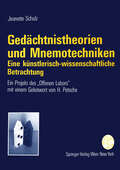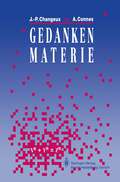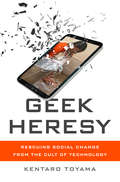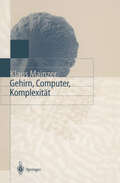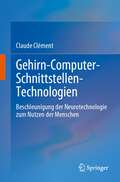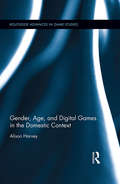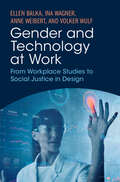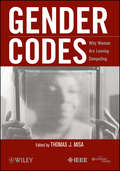- Table View
- List View
GDPR Requirements for Biobanking Activities Across Europe
by Sabrina Brizioli Alessandra LangellaThe book deals with the effective operation of the rules related to biomedical research and pays attention to the activities of the national legislatures of the 27 Member States in the field of scientific research. This multilevel system has an impact on biobanking activity. The book answers questions realized by operators on the main biobanks around the EU in the field of GDPR. The authors and editors used the questions born from brainstorming among members of the Association European, Middle East & Africa for Biopreservation and Biobanking (ESBB) to offer to the operators in biobanking activity and researchers quickly answer to their daily questions, but with authors highest quality. Further the book provides a comprehensive review of the rapidly expanding field of biobanking. It provides researchers and scholars working on biobanking and bio-sharing and more in general in the university hospitals and clinical trial consortiums, and companies, biomedical researchers, but also jurists and the professionals (in particular judges, lawyers, officers) an instrument rigorous but easy to use of the GDPR in the case of biobanking activities. The book identifies a methodological path to tackle the legal or ethical problem on a specific scientific-technological to verify existing solutions and give ideas for future applications. The importance of the legal solution influences the implementation of the development of the biobanking activity service itself.
Gearing up and accelerating cross‐fertilization between academic and industrial robotics research in Europe: Technology transfer experiments from the ECHORD project (Springer Tracts in Advanced Robotics #94)
by Florian Röhrbein Germano Veiga Ciro NataleThis monograph by Florian Röhrbein, Germano Veiga and Ciro Natale is an edited collection of 15 authoritative contributions in the area of robot technology transfer between academia and industry. It comprises three parts on Future Industrial Robotics, Robotic Grasping as well as Human-Centered Robots. The book chapters cover almost all the topics nowadays considered ‘hot’ within the robotics community, from reliable object recognition to dexterous grasping, from speech recognition to intuitive robot programming, from mobile robot navigation to aerial robotics, from safe physical human-robot interaction to body extenders. All contributions stem from the results of ECHORD – the European Clearing House for Open Robotics Development, a large-scale integrating project funded by the European Commission within the 7th Framework Programme from 2009 to 2013. ECHORD’s two main pillars were the so-called experiments, 52 small-sized industry-driven research projects, and the structured dialog, a powerful interaction instrument between the stakeholders. The results described in this volume are expected to shed new light on innovation and technology transfer from academia to industry in the field of robotics.
Gearing Up and Accelerating Cross‐fertilization between Academic and Industrial Robotics Research in Europe: Technology Transfer Experiments from the ECHORD Project (Springer Tracts in Advanced Robotics #94)
by Florian Röhrbein Germano Veiga Ciro NataleThis monograph by Florian Röhrbein, Germano Veiga and Ciro Natale is an edited collection of 15 authoritative contributions in the area of robot technology transfer between academia and industry. It comprises three parts on Future Industrial Robotics, Robotic Grasping as well as Human-Centered Robots. The book chapters cover almost all the topics nowadays considered ‘hot’ within the robotics community, from reliable object recognition to dexterous grasping, from speech recognition to intuitive robot programming, from mobile robot navigation to aerial robotics, from safe physical human-robot interaction to body extenders. All contributions stem from the results of ECHORD – the European Clearing House for Open Robotics Development, a large-scale integrating project funded by the European Commission within the 7th Framework Programme from 2009 to 2013. ECHORD’s two main pillars were the so-called experiments, 51 small-sized industry-driven research projects and the structured dialog a powerful interaction instrument between the stakeholders. The results described in this volume are expected to shed new light on innovation and technology transfer from academia to industry in the field of robotics.
Gebrauchsanleitungen optimal gestalten: Über sinnvolle und verständliche Gestaltung (X.media.press)
by Jona PiehlDer Schwerpunkt dieses Buches liegt in der Auseinandersetzung mit Prozessen der menschlichen Wahrnehmung und den Möglichkeiten, Wahrnehmung, den Informationstransfer im Rahmen der Konzeption und Gestaltung von Gebrauchsanleitungen, zu steuern und zu optimieren. Umfassend werden Kriterien und Lösungsmöglichkeiten vorgestellt. Anhand einer Reihe von Anleitungen werden diese Aspekte umgesetzt und überprüft. Inhaltlich befassen sich diese Beispielanleitungen mit Details des täglichen Lebens. Dem Leser wird es selbst überlassen, ob er fundierte Informationen herausnehmen, oder ob er über den Sinn von Gebrauchsanleitungen nachdenken möchte. Die Spannung entsteht durch die ungewöhnliche Kombination von theoretischen Überlegungen und Illustrationen, die nicht nur die verbalen Inhalte bebildern, sondern eigene assoziative Inhalte tragen.
Gedächtnistheorien und Mnemotechniken: Eine künstlerisch-wissenschaftliche Betrachtung
by Jeanette SchulzDie geistige Schöpferkraft und das Gedächtnis sind unverzichtbare Vorbedingungen für das Wissen und die Kulturen der Welt. Während die Antike und das Mittelalter die große Bedeutung beider Faktoren noch klar anerkannte, wurde die Wichtigkeit des Gedächtnisses und seiner Schulung später immer weniger beachtet. Die Autorin - Künstlerin und Neurowissenschaftlerin - beschäftigte sich eingehend mit den Gedächtnistheorien und Mnemotechniken seit der Antike. Vor diesem Hintergrund entstand ein Werk, das weniger als Lehrbuch gedacht ist, sondern einen kurzen, amüsant bebilderten Streifzug durch die Ansichten der letzten zweieinhalb Jahrtausende bietet. Die humorvollen und häufig bizarren Bilder zeugen nicht nur von überschäumender Phantasie und Kreativität, sondern unterstreichen auch, wie wichtig es ist, für Gedächtnisstützen möglichst irreale Gebilde heranzuziehen.
A Geek Girl's Guide to Electronics and the Internet of Things
by Audrey O'SheaA straightforward demystification of electronics and the Internet of Things A Geek Girl's Guide to Electronics and the Internet of Things breaks down and simplifies electronics and the Internet of Things for the layperson. Written by a leading technical school instructor with a talent for bringing complex topics to everyday people, this book provides concrete examples and practical advice for anyone interested in building, repairing, or studying electronics and functional Internet of Things (IoT) devices. A Geek Girl’s Guide to Electronics and the Internet of Things explores a wide range of topics including, among others: Ohm’s and Watt's Law Series and Parallel Circuits Diodes, transistors, capacitors and relays Motors and Pulse with Modulation Using light to control electricity Photovoltaic Cells and Transducers Enhancing circuits with Arduino Connecting circuits to networks The distinguished author’s website includes videos to help you build and enhance projects, along with deeper information to enrich your learning. Additionally, the book goes beyond theory and teaches readers how circuit components become IoT devices and provide the data that drive our modern world. The combination of hands-on activities and solid pedagogy ensures long-lasting retention of the material for everyone.
A Geek Girl's Guide to Electronics and the Internet of Things
by Audrey O'SheaA straightforward demystification of electronics and the Internet of Things A Geek Girl's Guide to Electronics and the Internet of Things breaks down and simplifies electronics and the Internet of Things for the layperson. Written by a leading technical school instructor with a talent for bringing complex topics to everyday people, this book provides concrete examples and practical advice for anyone interested in building, repairing, or studying electronics and functional Internet of Things (IoT) devices. A Geek Girl’s Guide to Electronics and the Internet of Things explores a wide range of topics including, among others: Ohm’s and Watt's Law Series and Parallel Circuits Diodes, transistors, capacitors and relays Motors and Pulse with Modulation Using light to control electricity Photovoltaic Cells and Transducers Enhancing circuits with Arduino Connecting circuits to networks The distinguished author’s website includes videos to help you build and enhance projects, along with deeper information to enrich your learning. Additionally, the book goes beyond theory and teaches readers how circuit components become IoT devices and provide the data that drive our modern world. The combination of hands-on activities and solid pedagogy ensures long-lasting retention of the material for everyone.
Geek Heresy: Rescuing Social Change from the Cult of Technology
by Kentaro ToyamaIn 2004, Kentaro Toyama, an award-winning computer scientist, moved to India to start a new research group for Microsoft. Its mission: to explore novel technological solutions to the world's persistent social problems. Together with his team, he invented electronic devices for under-resourced urban schools and developed digital platforms for remote agrarian communities. But after a decade of designing technologies for humanitarian causes, Toyama concluded that no technology, however dazzling, could cause social change on its own.Technologists and policy-makers love to boast about modern innovation, and in their excitement, they exuberantly tout technology's boon to society. But what have our gadgets actually accomplished? Over the last four decades, America saw an explosion of new technologies - from the Internet to the iPhone, from Google to Facebook - but in that same period, the rate of poverty stagnated at a stubborn 13%, only to rise in the recent recession. So, a golden age of innovation in the world's most advanced country did nothing for our most prominent social ill.Toyama's warning resounds: Don't believe the hype! Technology is never the main driver of social progress. Geek Heresy inoculates us against the glib rhetoric of tech utopians by revealing that technology is only an amplifier of human conditions. By telling the moving stories of extraordinary people like Patrick Awuah, a Microsoft millionaire who left his lucrative engineering job to open Ghana's first liberal arts university, and Tara Sreenivasa, a graduate of a remarkable South Indian school that takes children from dollar-a-day families into the high-tech offices of Goldman Sachs and Mercedes-Benz, Toyama shows that even in a world steeped in technology, social challenges are best met with deeply social solutions.
Geek Sublime: Writing Fiction, Coding Software
by Vikram ChandraA great novelist on his twin obsessions: writing and coding. What is the relationship between the two? Is there such a thing as the sublime in code? Can we ascribe beauty to the craft of coding? Vikram Chandra is the award-winning author of two acclaimed novels and a collection of short stories - and has been a computer programmer for almost as long as he has been a writer. In his extraordinary new book he looks at the connection between these two worlds of art and technology. Coders are obsessed with elegance and style, just as writers are, but do the words mean the same thing to both? And is it a coincidence that Chandra is drawn to two seemingly opposing ways of thinking?Exploring these questions, Chandra creates an idiosyncratic history of coding - exploring such varied topics as logic gates and literary modernism, the male machismo of geeks, the striking presence of an 'Indian Mafia' in Silicon Valley, and the writings of Abhinavagupta, the 10th - 11th century Kashmiri thinker. Part technology story and part memoir, Geek Sublime is a book of sweeping ideas. It is a heady and utterly original work.
Gefühlte Zukunft: Emotionen als methodische Herausforderung für die Zukunftsforschung (Zukunft und Forschung)
by Katharina Schäfer Karlheinz Steinmüller Axel ZweckWelche Rolle spielen Emotionen bei der Konstruktion, Kommunikation und Nutzung von Zukunftsbildern? Sind Emotionen primär eine Komponente, die Vorurteile transportiert? In welchem Maße sind Forschende selbst Emotionen ausgesetzt, die die Methodenwahl und die Ergebnisse beeinflussen? In dem Sammelband kommt die gesamte Breite der Thematik „Zukunftsforschung und Emotionalität“ zur Sprache, von den philosophischen Grundlagen bis zu methodischen Fragestellungen und Erkenntnissen aus der Praxis, die die enge Verschränkung von Kognition und Emotion in allen Phasen von Vorausschauprozessen belegen.
Gehirn, Computer, Komplexität
by Klaus MainzerKlaus Mainzer gibt einen faszinierenden Einblick in die Komplexität des Denkens und zeigt die Möglichkeiten und Grenzen künstlicher Intelligenz und künstlichen Lebens auf.
Gehirn-Computer-Schnittstellen-Technologien: Beschleunigung der Neurotechnologie zum Nutzen der Menschen
by Claude ClémentDieses Buch befasst sich mit dem Bereich der Gehirn-Computer-Schnittstellen (BCI) und dem einzigartigen und besonderen Umfeld aktiver Implantate, die eine elektrische Schnittstelle zum Gehirn, zum Rückenmark, zu peripheren Nerven und zu Organen bilden. Im Mittelpunkt des Buches steht die Heilung und Rehabilitation von Patienten mit schweren neurologischen Beeinträchtigungen, von Lähmungen bis hin zu Bewegungsstörungen und Epilepsie, die oft eine invasive Lösung auf der Grundlage eines implantierten Geräts erfordern. Frühere Errungenschaften, aktuelle Arbeiten und Zukunftsperspektiven von BCI und anderen Interaktionen zwischen medizinischen Geräten und dem menschlichen Nervensystem werden aus pragmatischer Sicht ausführlich beschrieben. gibt einen Überblick über die Branche der aktiven implantierbaren medizinischen Geräte (AIMDs) und wie sie sich von kardialen zu neurologischen Anwendungen entwickelt Klare, leicht zu lesende Darstellung des Bereichs der Neurotechnologien zum Nutzen des Menschen Bietet leicht verständliche Erklärungen zu den technischen Grenzen, den physikalischen Eigenschaften von Implantaten im menschlichen Körper und realistischen langfristigen Perspektiven
Gelenkgetriebe für die Handhabungs- und Robotertechnik: Drei Programmsysteme für den HP-41 CV mit vielen Beispielen (Vieweg-Programmbibliothek Mikrocomputer #17)
by Kurt HainGelenkgetriebe-Konstruktion: mit Kleinrechnern HP Serie 40 (HP 41C/CV) und HP Serie 80 (HP-83, HP-85, HP-86, HP-87) (Anwendung von Mikrocomputern #9)
by Kurt HainGeminoid Studies: Science and Technologies for Humanlike Teleoperated Androids
by Hiroshi Ishiguro Fabio Dalla LiberaThis book describes the teleoperated android Geminoid, which has a very humanlike appearance, movements, and perceptions, requiring unique developmental techniques. The book facilitates understanding of the framework of android science and how to use it in real human societies. Creating body parts of soft material by molding an existing person using a shape-memory form provides not only the humanlike texture of the body surface but also safe physical interaction, that is, humanlike interpersonal interaction between people and the android. The teleoperation also highlights novel effects in telecommunication. Operators of the Geminoid feel the robot's body as their own, and people encountering the teleoperated Geminoid perceive the robot's body as being possessed by the operator as well.Where does the feeling of human presence come from? Can we transfer or reproduce human presence by technology? Geminoid may help to answer these questions.
Gems of Combinatorial Optimization and Graph Algorithms
by Andreas S. Schulz Martin Skutella Sebastian Stiller Dorothea WagnerAre you looking for new lectures for your course on algorithms, combinatorial optimization, or algorithmic game theory? Maybe you need a convenient source of relevant, current topics for a graduate student or advanced undergraduate student seminar? Or perhaps you just want an enjoyable look at some beautiful mathematical and algorithmic results, ideas, proofs, concepts, and techniques in discrete mathematics and theoretical computer science? Gems of Combinatorial Optimization and Graph Algorithms is a handpicked collection of up-to-date articles, carefully prepared by a select group of international experts, who have contributed some of their most mathematically or algorithmically elegant ideas. Topics include longest tours and Steiner trees in geometric spaces, cartograms, resource buying games, congestion games, selfish routing, revenue equivalence and shortest paths, scheduling, linear structures in graphs, contraction hierarchies, budgeted matching problems, and motifs in networks. This volume is aimed at readers with some familiarity of combinatorial optimization, and appeals to researchers, graduate students, and advanced undergraduate students alike.
Gems of Theoretical Computer Science
by Uwe Schöning Randall J. PruimThis book assembles some of the most important problems and solutions in theoretical computer science-from computability, logic, circuit theory, and complexity. The book presents these important results with complete proofs in an understandable form. It also presents previously open problems that have found (perhaps unexpected) solutions, and challenges the reader to pursue further active research in computer science.
Gender, Age, and Digital Games in the Domestic Context (Routledge Advances in Game Studies)
by Alison HarveyWestern digital game play has shifted in important ways over the last decade, with a plethora of personal devices affording a range of increasingly diverse play experiences. Despite the celebration of a more inclusive environment of digital game play, very little grounded research has been devoted to the examination of familial play and the domestication of digital games, as opposed to evolving public and educational contexts. This book is the first study to provide a situated investigation of the site of family play— the shared spaces and private places of gameplay within the domestic sphere. It carries out an empirically grounded and critical analysis of what marketing and sales discourses about shifts in the digital games audience actually look like in the space of the home, as well as the social and cultural role these ludic technologies take in the everyday practices of the family in the domestic context. It examines the material realities of video game technologies in the home; including time management and spatial organization, as well as the discursive role these devices play in discussions of technological competence and its complex relationship to age, generational differences, and gender performance. Harvey’s interdisciplinary approach and innovative methodology will hold great critical appeal for those studying digital culture, children’s media, and feminist studies of new media, as well as critical theories of technology and leisure and sport theory.
Gender, Age, and Digital Games in the Domestic Context (Routledge Advances in Game Studies)
by Alison HarveyWestern digital game play has shifted in important ways over the last decade, with a plethora of personal devices affording a range of increasingly diverse play experiences. Despite the celebration of a more inclusive environment of digital game play, very little grounded research has been devoted to the examination of familial play and the domestication of digital games, as opposed to evolving public and educational contexts. This book is the first study to provide a situated investigation of the site of family play— the shared spaces and private places of gameplay within the domestic sphere. It carries out an empirically grounded and critical analysis of what marketing and sales discourses about shifts in the digital games audience actually look like in the space of the home, as well as the social and cultural role these ludic technologies take in the everyday practices of the family in the domestic context. It examines the material realities of video game technologies in the home; including time management and spatial organization, as well as the discursive role these devices play in discussions of technological competence and its complex relationship to age, generational differences, and gender performance. Harvey’s interdisciplinary approach and innovative methodology will hold great critical appeal for those studying digital culture, children’s media, and feminist studies of new media, as well as critical theories of technology and leisure and sport theory.
Gender and Distance Education: Indian and International Contexts
by Anu AnejaThis book investigates the intersection of gender and distance education from a feminist perspective and explores their contemporary innovative interfaces in Indian and international contexts. The key issues raised here include a re- investigation of the democratizing potential of distance education from a gendered perspective (especially in developing countries such as India), feminist pedagogical perspectives on the notion of transactional distance, the relationship between masculinity and gerontology from the perspective of non- traditional modes, and the interrelationships between gender and social media from a distance education perspective. As opposed to the conventional, physical classroom, the virtual classroom often occupies a de- privileged space in feminist pedagogical discussions, since it appears to align itself less easily with feminist praxes which encourage a free, intellectual exchange between teachers and students. By opening up various facets of the relationship between gender, distance education and feminist pedagogy, the book foregrounds the critical need to re- visit preconceived, unfavourable assumptions about this relationship and proposes mutually productive inter-linkages. It does so in the context of contemporary circumstances defined by the increasing use of virtual technology, the ongoing need for democratization of higher education and the constraints posed by consumerist trends. Lucid and topical, this Focus volume will be useful to scholars and researchers of higher education, open and distance education, feminist pedagogy, gender studies, feminism, masculinity, and women’s studies as well as practitioners and policymakers working in the education sector.
Gender and Distance Education: Indian and International Contexts
by Anu AnejaThis book investigates the intersection of gender and distance education from a feminist perspective and explores their contemporary innovative interfaces in Indian and international contexts. The key issues raised here include a re- investigation of the democratizing potential of distance education from a gendered perspective (especially in developing countries such as India), feminist pedagogical perspectives on the notion of transactional distance, the relationship between masculinity and gerontology from the perspective of non- traditional modes, and the interrelationships between gender and social media from a distance education perspective. As opposed to the conventional, physical classroom, the virtual classroom often occupies a de- privileged space in feminist pedagogical discussions, since it appears to align itself less easily with feminist praxes which encourage a free, intellectual exchange between teachers and students. By opening up various facets of the relationship between gender, distance education and feminist pedagogy, the book foregrounds the critical need to re- visit preconceived, unfavourable assumptions about this relationship and proposes mutually productive inter-linkages. It does so in the context of contemporary circumstances defined by the increasing use of virtual technology, the ongoing need for democratization of higher education and the constraints posed by consumerist trends. Lucid and topical, this Focus volume will be useful to scholars and researchers of higher education, open and distance education, feminist pedagogy, gender studies, feminism, masculinity, and women’s studies as well as practitioners and policymakers working in the education sector.
Gender and Technology at Work: From Workplace Studies to Social Justice in Design
by null Ellen Balka null Ina Wagner null Anne Weibert null Volker WulfThis book brings together the vast research literature about gender and technology to help designers understand what a gender perspective and a focus on intersectionality can contribute to designing information technology systems and artifacts, and to assist organizations as they work to develop work cultures that are supportive of women and marginalized genders and people. Drawing on empirical and analytical studies of women's work and technology in many parts of the world, the book addresses how to make invisible aspects of work visible; how to recognize women's skills without falling into the trap of gender stereotyping; how to engage in improving working conditions; and how to defend care of life situations and needs against a managerial logic. It addresses challenges for design, including many overlooked and undervalued aspects, such as the complexities involved in human–machine interactions, as well as the need to create safe spaces for research subjects.
Gender Codes: Why Women Are Leaving Computing
by Thomas J. MisaThe computing profession faces a serious gender crisis. Today, fewer women enter computing than anytime in the past 25 years. This book provides an unprecedented look at the history of women and men in computing, detailing how the computing profession emerged and matured, and how the field became male coded. Women's experiences working in offices, education, libraries, programming, and government are examined for clues on how and where women succeeded—and where they struggled. It also provides a unique international dimension with studies examining the U.S., Great Britain, Germany, Norway, and Greece. Scholars in history, gender/women's studies, and science and technology studies, as well as department chairs and hiring directors will find this volume illuminating.




